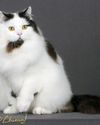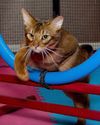Using Advanced Technologies: Within a Breeding Program
Cat Talk
|February 2021
Most dedicated animal breeders have more than a passing knowledge of basic genetics and will carefully screen their breeding stock for genetic defects and phenotypic traits.

While there are a wealth of scholarly studies regarding what DNA sequences line up with what disease mutations or the complexities of phenotypic traits such as tabby (agouti) patterns, there is little information or advice on what to do with this information once a breeder acquires it. You might say, “What do you mean, do with it? If your cat screens positive for a defect, that cat should not be used in a breeding program. If you don’t want any color point kittens popping out of two tabby parents, make sure you don’t put two color point carriers together. Why would there need to be a study? Isn’t that obvious?”
Bu hikaye Cat Talk dergisinin February 2021 baskısından alınmıştır.
Binlerce özenle seçilmiş premium hikayeye ve 9.000'den fazla dergi ve gazeteye erişmek için Magzter GOLD'a abone olun.
Zaten abone misiniz? Oturum aç
Cat Talk'den DAHA FAZLA HİKAYE

Cat Talk
Holiday Aromatics
Are They Naughty or Nice?
3 mins
December 2024

Cat Talk
Feline Photographers Part 2
Social media is rife with pictures of our pets, especially cats.
11 mins
December 2024

Cat Talk
Celebrating the Season With Our Cats
As this writer began work on this project to find holiday stories involving cats, she was amazed to find that there are ELEVEN religious holidays celebrated during December!
4 mins
December 2024

Cat Talk
How Cats Find Their Owners
A month after losing her beloved senior cat, a woman named Amin Diane was parked on a street at night, waiting for her friend.
5 mins
December 2024

Cat Talk
Remembering Willa Hawke
Retired CFA Judge Emeritus Willa Hawke passed away August 2, 2024 in Lake Kiowa, TX at the age of 88. She had been a judge for over 50 years before her retirement in 2016.
1 mins
December 2024

Cat Talk
UP CLOSE AND Purr-sonal
Thoughtful... Caring ... Giving ...Helpful... Committed.
4 mins
December 2024

Cat Talk
DON'T PUFF AROUND PUFF!
THE EFFECT OF SECONDHAND SMOKE ON CATS
5 mins
December 2024

Cat Talk
Fluffy Coats
AND HOW TO CARE FOR THEM
7 mins
December 2024

Cat Talk
Feline Agility?
I Thought Agility Was For Dogs!
7 mins
December 2024

Cat Talk
Come Fly With Me!
TIPS ON NAVIGATING AIRPORT SECURITY WITH YOUR CAT
4 mins
December 2024
Translate
Change font size

